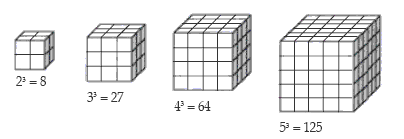Solve problems that involve exponents and square roots.
Number Framework Stage 8
Rubber bands
Unilink cubes
Using Materials
Get the students to work together to make four stacks of two cubes, nine stacks of three cubes, 16 stacks of four cubes, and 25 stacks of five cubes. Put four loose cubes down and form them into a 2 x 2 square shape. Do the same with nine cubes (3 x 3), 16 cubes (4 x 4), and 25 cubes (5x 5).
Ask the students to work out the total number of cubes in each square. Tell the students that these numbers are sometimes referred to as “two squared”, “three squared,” “four squared”, etc. They are written as 22, 32, 42, etc.
Tell the students to put one of the product numbers (e.g., 16) into the calculator and press the square root button (√ ). Repeat for the other three products. Ask the students what the square root button does. (It gives the length of each side of the square, e.g. √16 = 4.) Test this out by getting the students to calculate 100 = 10. A 10 x 10 square has an area of 100.
Using rubber bands, make the stacks of cubes into 2 x 2 x 2, 3 x 3 x 3, 4 x 4 x 4, and 5 x 5 x 5 cubes. Ask the students to calculate how many small cubes make up each larger cube. Encourage them to use mental strategies, such as 4 x 4 = 16, 4 x 16 = 8 x 8 = 64, that involve splitting factors. Tell the students that these numbers are sometimes called “two cubed”, “three cubed,” “four cubed,” etc., and are written as 23, 33, 43 etc.
Using Imaging
Ask the students to describe what models for these powers would look like and what the number would be:
82 (64), 63 (216), √81 (9), 1002 (10 000), 103 (1 000), √ 400 (20)
Tell the students that numbers can be raised to the powers of 4, 5, 6, and so on. The number involved becomes very large, so it is not usually practical to make models of them. For example, 54 (5 to the power of 4) = 5 x 5 x 5 x 5 = 625. Get the students to calculate numbers to higher powers, such as 26 = 2 x 2 x 2 x 2 x 2 x 2 = 64.
Using Number Properties
Draw up a table of the power of two (exponents with two as a base, as in the first row of the table below). Leave the values of 20 and 21 empty (in the second row).Fill in the table as the students mentally calculate the next number each time by doubling:
Ask the students what 20 and 21 must be if the pattern of doubling to the right and halving to the left still holds (21 = 2 and 20 = 1).
Tell the students to work out 8 x 32 = 256 mentally. Note that the answer is in the table as well. Record this as 23 x 25 = 28. Give the students two other similar problems, e.g., 64 x 8 = 512 (26 x 23 = 29) and 256 x 4 = 28 x 22 = 210.
Some students may note that adding the exponents of the factors gives the exponent of the product. This idea can be tested out with other examples for the powers of two table and also by constructing a powers of three table:
Challenge the students to explain why 32 x 33 = 35.
Record this as: (3 x 3) x ( 3 x 3 x 3) = (3 x 3 x 3 x 3 x 3). The students should note that the factors are the same, they are just grouped in different ways.
Provide other examples for them to explain, e.g., 24 x 25 = 29.
Challenge the students to use their calculators to find out what happens when powers are divided. For example: 210 ÷ 24 = 26, 27 ÷ 23 = 23, 35 ÷ 34 = 31, 39 ÷ 35 = 34.
The students should notice that the exponents are subtracted to find the exponent of the quotient. They may like to investigate what a number to the power of one-half must be (16 1/2 = √ 16 and 811/2 = √81= 9)



